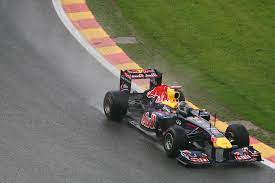
With Sebastian Vettel’s recent and unexpected departure, questions are being asked of how F1 crowns a new World Champion. Max Verstappen was crowned champion last year by just 1 point from Lewis Hamilton; but when the stewards investigated his first-corner crash in Spain this season, he lost out on that title to Hamilton for good.
Max Verstappen is the youngest ever Formula One world champion. He won his first title at age 17, and then again at age 20.
ABU DHABI, United Arab Emirates — On Sunday night, Red Bull team principal Christian Horner marched to the stewards’ office in a t-shirt boldly proclaiming Max Verstappen as the 2021 world champion to defend the same statement imprinted across his breast.
Horner had been on the Abu Dhabi podium only four hours before, celebrating Verstappen’s maiden world championship. By this time, he should have been going down the red carpet at one of Red Bull’s famed after parties, but the champagne was still on ice as the clock approached 11 p.m.
Throughout the weekend, jokes were made about how the stewards’ office would determine this year’s great championship race between Verstappen and Lewis Hamilton. The stewards — F1’s rotating team of referees — had had a role in the result of the previous three races in Brazil, Qatar, and Saudi Arabia, with other incidents interspersed throughout earlier rounds of the season. However, it was assumed that the stewards would rule on an incident between the two drivers, rather than the acts of the FIA’s own race director, Michael Masi.
Horner was joined by Red Bull’s long-time technical director Adrian Newey and the team’s sports director Jonathan Wheatley as he proceeded towards the stewards. For the multiple cameramen backpedaling in front of them, all three donned serious expressions. All three seemed to be in the mood for a brawl.
Mercedes’ representative arrived shortly after. Team manager Ron Meadows and Mercedes’ legal counsel, Paul Harris QC, joined engineering director Andrew Shovlin. Their stride was no less deliberate, but they evaded the concentration of the camera lenses and the brightness of the spotlights by arriving shortly behind Red Bull, passing past the automated doors protecting the stewards’ office relatively unseen.
By this time in the evening, both teams had presented their arguments to the stewards on the events leading up to the thrilling last lap that decided the championship. Verstappen had overtaken Hamilton with less than two kilometers remaining in the 2021 world championship, but his ability to do so had been contingent on a contentious decision by Masi. Mercedes challenged the verdict, which is understandable given the circumstances of this year’s championship. The two teams were now returning to the stewards to see whether the race outcome might be changed and to plan their next moves.
2 Related
The doors of the stewards’ office swung open again after a lengthy 10 minutes, and the Mercedes trio emerged.
There was no response. There has been no news on the result.
Horner, Newey, and Wheatley reappeared five minutes later, facemasks hiding what looked to be the tiniest of grins. Again, there is no response.
A solitary cheer broke out from one of the hospitality units as the Red Bull executives made their way back along the paddock, trailed by cameramen and reporters. A collective ding of journalists’ phones resonated across the paddock moments later, confirming news from Red Bull’s director of communications: “Protest NOT upheld.”
Horner received stronger chants and applause as he moved closer to Red Bull’s hospitality. Suddenly, scores of team members, including Verstappen himself, appeared to meet the returning team managers.
Verstappen was cool and serene during the race, as he had been all along. He walked past the media throng outside the hospitality unit in shorts and a team jersey, saying little more than a few words to the photographers as he made his way to the team’s garage door. As soon as he walked inside the garage, his technicians cranked up the volume on Queen’s “We Are the Champions.”
Verstappen has won the world championship for the second time in one evening.
After the stewards denied Mercedes’ challenge, Max Verstappen celebrated his championship triumph (again) on Sunday evening. Getty Images via ANP Sport
A protester’s appeal
Despite this, it isn’t officially over yet. Red Bull and Verstappen celebrated the stewards’ decision knowing there was still a possibility it would not be final, much as a powerful boxer might do in the ring before the judges announce the results.
Mercedes acknowledged the obvious and announced its intention to appeal the verdict within 30 minutes of the announcement that the protest had failed. When a team files an intent to appeal, they have 96 hours to prepare a case, which is then presented to the FIA’s International Court of Appeal if it is found admissible. Mercedes may still appeal, but for the time being, Verstappen is a world champion with an asterisk.
Unworthy of two champions, a championship decider
It was perhaps the worst manner for Formula One to proclaim a new champion. On a day when the whole athletic world was watching, F1 presented an unattractive image of itself, mired in byzantine laws that were improperly implemented. Sure, there was drama on the last lap, but at what cost?
To make things worse, the drivers and teams involved had nothing to do with it. Verstappen and Red Bull fought hard throughout the Abu Dhabi Grand Prix to stay in contention, and the fact that they were able to take advantage of the scenario at the end is a testament to both driver and team for rolling the dice over and over again when all hope seemed to be gone.
Make no mistake: Verstappen is a deserving world champion, and it would seem unfair to rob him of his championship at this point… yet Mercedes has a compelling case.
The historic season-long fight between Lewis Hamilton and Max Verstappen deserved a better conclusion. Getty Images/Lars Baron
What went wrong, exactly?
The problem wasn’t so much how the last lap shootout went down, with Verstappen lunging past Hamilton at Turn 5, but rather what happened before that. Nicholas Latifi crashed into the barriers beneath the swanky W Hotel on lap 53 of 58, resulting in a safety car. Mercedes had spent the previous 38 circuits, since Hamilton’s solitary pit stop on lap 15, praying that such an occurrence would not occur, but it did.
Because of the positions of Hamilton and Verstappen on the track, Mercedes was unable to take advantage of the chance to pit Hamilton for new tyres. If the team had done so, Verstappen would have taken the lead and the race would have concluded under the safety car, with Verstappen proclaimed champion as a consequence of Mercedes’ choice to stop.
There were no such issues for Red Bull when it came to pitting since there was nothing to lose. If Verstappen pitted, the new tyres would give him a performance edge over Hamilton if the race resumed, but he would still be second when he returned to the circuit. He’d lose track position to five lapped vehicles, but it wasn’t a big deal at the time since the regulations stated that once the race resumed, all lapped cars would unlap themselves. Due to the performance advantage of his fresh tyres, Verstappen would have a clean opportunity at overhauling Hamilton in the last laps (or laps, as it turned out).
2 Related
The championship contenders became part of a serpentine tail of F1 vehicles behind the safety car when Hamilton elected to remain out and Verstappen stopped for new tyres. It was only before that moment when Hamilton realized the gravity of the issue. He told his race engineer Peter Bonnington, “[Censored], I can’t box.”
Bonnington said, “Negative.”
Hamilton’s response to the message was completely removed due to profanity.
Bonnington briefed his driver on the facts on lap 54 of 58, while remaining behind the safety car.
“Verstappen has pitted, he had a free pit stop, but if we had pitted, we would have lost track position to him. When you reach the finish line, you still have four laps to go. This field must gather, and then lapped cars must pass, thus this race may not resume.”
Hamilton said, “Is he directly behind me?”
“Once they’ve sorted out the sequence, he’ll be there. This will take some time to resolve.”
“Do you have new tyres?”
“Lewis, please copy. If we had pitted, we would have lost track position.”
With three circuits remaining, race management deviated from policy and informed the teams that lapped vehicles would not be permitted to unlap themselves. This was an effort, while not stated at the time, to get racing back on track as quickly as possible so that the championship might be decided on a racing lap rather than behind the safety car.
The decision was very contentious since it meant there would be five cars between Hamilton and Verstappen at the restart, thereby eliminating any opportunity Verstappen had of passing Hamilton on his new tyres. Verstappen had just lost a few of seconds behind Hamilton after picking his way through the same group of vehicles a few circuits before, so there was no way he could clear all five of them in one lap and beat Hamilton.
Even if there had been blue flags directing lapped vehicles to get out of the way, Verstappen would have likely caught Hamilton at the end of the lap, when any opportunity of passing would have been restricted by the narrow final sector. Gianpiero Lambiase, Verstappen’s engineer, conveyed the news to his driver.
Lambiase said, “Lapped automobiles will not be permitted to overtake.”
“Of course,” Verstappen said, “typical choice.”
“It’s classic,” Lambiase says.
“I’m not surprised,” Verstappen says.
Horner chimed in at this moment, but instead of speaking with his driver, he opened a radio channel to race director Michael Masi, who had taken the decision to forego the standard process.
“Michael, it’s Christian,” Horner says.
“Yes, go ahead,” Masi says.
“Why aren’t we getting these lapped vehicles out of the way?” Horner wonders.
Masi, who seemed frazzled as he juggled the radio conversation with overseeing Latifi’s car’s evacuation from the track, added: “Give me a second… because Christian… give me a second. The most important goal for me is to clear up this occurrence.”
“You just need one racing lap,” Horner says.
Masi then determined that the five cars between Hamilton and Verstappen would be allowed to unlap themselves while the remainder of the lapped vehicles lower down the order would stay in place, despite there being no precedence for a safety car restart in F1 history. It met Horner’s desire for a shootout between the top two drivers, but it made a mockery of the sport from third place.
For the most of the race, Lewis Hamilton was in front of Max Verstappen. Getty Images/Lars Baron
Two lapped cars were still stranded between Verstappen in second and Carlos Sainz in third, while one was stalled lower down the order between Valtteri Bottas and Yuki Tsunoda. Furthermore, Daniel Ricciardo, who pitted under the safety car for the identical reasons as Verstappen, lost a lap behind all of the cars he had intended to challenge on his new tyres.
The FIA did not explain the decision after the race, but it seems Masi took the choice to speed up the conclusion of the safety car and allow Hamilton and Verstappen to race head-to-head on the last lap regardless of what transpired farther back. While it was entertaining, it was also very troublesome.
Masi’s goal as race director is not to give Sunday entertainment, but to ensure a safe and fair race by following the FIA’s sports standards. Verstappen was handled differently than Sainz and given a huge advantage by having lapped vehicles between them but no lapped cars between them and Hamilton, for example. It also ensured that Verstappen’s fresh soft tyres would always provide him a performance advantage over Hamilton’s 43-lap old hard tyres, allowing him to try an overtaking.
Furthermore, Masi had to not only fudge the rule about cars unlapping themselves, but he also had to bring the restart forward by a single lap, ignoring another part of the same rule (Article 48.12), which states that the restart should take place on the lap after the last of the lapped cars has unlapped itself. If that process had been followed in its entirety, even with only the five cars unlapping themselves, the safety car would not have been allowed to enter the pits until the conclusion of the penultimate lap, denying Verstappen the opportunity to overtake.
While no one wanted the championship to conclude with a safety car, it did in Brazil in 2012 when Sebastian Vettel defeated Fernando Alonso to the title, and no one questioned the decision. But it’s also true that Masi wasn’t in charge of the race at the time.
Masi put the sport on unstable footing by changing the regulations to meet the moment. On a day when the spotlight should have been on the two drivers vying for the title, it was instead focused on him because of his own conduct.
Toto Wolff, the head of the Mercedes team, was understandably furious.
At the start of the penultimate lap, he shouted over the Mercedes/FIA radio channel, “Michael, this isn’t right.”
Verstappen said as he overtook Hamilton: “No way, Michael! No way, Michael! That wasn’t right at all!”
The most notable radio discussion occurred after the race, when Wolff finally received a response from Masi.
“You need to restore the lap before, that’s not right,” Wolff stated.
“Toto, it’s called a motor race,” Masi said.
“Excuse me?” Wolff says.
“We went automobile racing,” Masi says.
The stewards invoked another guideline (Article 15.3 of the Sporting Regulations) to support Masi’s decision to allow only five vehicles unlap themselves in response to Mercedes’ objection. The race director has “overriding power” over “the use of the safety car,” meaning he may override restrictions if he thinks appropriate, according to the rule. While it makes sense for safety reasons, this was done for sporting purposes, and the regulations were actually modified from one lap to the next. Mercedes could reasonably argue that if it had known Masi could change the procedure to bring the safety car in early, it would have pitted Hamilton at the start of the safety car period.
Article 48.13 was also referenced by the stewards to explain why the safety car seemed to arrive a lap too early. The article stipulates that once race control displays the message “safety car in this lap,” as it did on lap 57, it is obligatory to pull the safety car back into the pits, therefore nullifying the clause to allow a lap between the last car unlapping itself and the race restarting.
What now?
Getty Images/Mark Thompson
Masi’s goal as race director should have been to deliver the spectacle that was lap 58 of the Abu Dhabi Grand Prix, or to safeguard the sport from protests and controversy by following the FIA’s own regulations. Simply put, does Masi’s job include ensuring an entertainment or sports spectacle?
Regardless of whether you support either driver or team, Masi’s choice to pick and choose which regulations to apply was not an appropriate approach to award a winner. It shouldn’t detract from Verstappen’s incredible success, but it does taint his maiden championship in a manner that isn’t fair to either Verstappen or the sport.
The Red Bull driver had little influence over the outcome of the race and just took advantage of the chance to overtake Hamilton on the penultimate lap when it arose. By his own admission, there was a significant amount of luck involved in Sunday’s race, but he correctly points to examples of bad luck in Hungary, where he was taken out at the start by Hamilton’s teammate Valtteri Bottas, and his tyre failure while leading the race in Azerbaijan as examples of how the pendulum can swing.
If Masi had let the race conclude under the safety car, Hamilton would have been a deserving champion, but there’s little question that decision would have sparked debate. Furthermore, attention would have shifted back to the first lap when the stewards opted not to penalize Hamilton for bypassing Turn 7 while protecting the lead from Verstappen.
But there is a silver lining in all of this for Formula One: those two deserving champions will return to the circuit next year to do fight once again. In the meanwhile, the FIA must examine its own standards and how they are applied to guarantee that such a championship finish is never repeated.
Watch This Video-
Max Verstappen is the youngest ever Formula 1 world champion. He won his first title in 2016 and then successfully defended it in 2017. Max has been crowned world champion twice, but how did he do it? Reference: max verstappen age.
Related Tags
- f1 season finale 2021
- max verstappen kelly piquet
- max verstappen salary
- max verstappen partner
- max verstappen net worth











